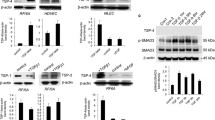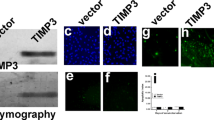Abstract
Our previous studies have revealed the abundant expression of T-cadherin—a glycosylphosphatidylinositol (GPI)-anchored member of cadherin superfamily—in endothelial and mural cells in the heart and vasculature. The upregulation of T-cadherin in vascular proliferative disorders such as atherosclerosis and restenosis suggests the involvement of T-cadherin in vascular growth and remodeling. However, the functional significance of this molecule in the vasculature remains unknown. The effect of T-cadherin on angiogenesis in vivo was evaluated using Matrigel implant model. We demonstrate that T-cadherin overexpression in L929 cells injected in Matrigel inhibits neovascularization of the plug. In vitro T-cadherin inhibits the directional migration of endothelial cells, capillary growth, and tube formation but has no effect on endothelial cell proliferation, adhesion, or apoptosis in vitro. These data suggest that T-cadherin expressed in the stroma could act as a negative guidance cue for the ingrowing blood vessels and thus could have an important potential therapeutic application.







Similar content being viewed by others
References
Cavallaro U, Leibner S, Dejana E (2006) Endothelial cadherins and tumor angiogenesis. Exp Cell Res 312:659–667
George SJ, Beeching CA (2006) Cadherin:catenin complex: a novel regulator of vascular smooth muscle cells behaviour. Atherosclerosis 188:1–11
Gumbiner BM (2005) Regulation of cadherin-mediated adhesion in morphogenesis. Nature Rev Mol Cell Biol 6:622–634
Perez-Moreno M, Jamora C, Fuchs E (2003) Sticky business: orchestrating cellular signals at adherens junctions. Cell 112:535–548
Rubina KA, Kalinina NI, Bochkov VN, Parfyonova YeV, Tkachuk VA (2005) T-cadherin as an antiadhesive and guidance molecule interacting with low density lipoproteins. Annals EAS 1–14
Ranscht B, Dours-Zimmermann MT (1991) T-cadherin, a novel cadherin cell adhesion molecule in the nervous system lacks the conserved cytoplasmic region. Neuron 7:391–402
Rubina KA, Tkachuk VA (2004) Antiadhesive molecule T-cadherin is an atypical low-density lipoprotein receptor in vascular cells. RJ Physiol 90:968–986
Philippova MP, Bochkov VN, Stambolsky DV, Tkachuk VA, Resink T (1998) T-cadherin and signal-transducing molecules co-localize in caveolin-rich membrane domain of vascular smooth muscle cells. FEBS Lett 129:201–210
Ivanov D, Philippova M, Antropova J, Gubaeva F, Iljinskaya O, Tararak E, Bochkov V, Erne P, Resink T, Tkachuk V (2001) Expression of cell adhesion molecule T-cadherin in the human vasculature. Histochem Cell Biol 115:231–242
Kudrjashova E, Bashtrikov P, Bochkov V, Parfyonova Y, Tkachuk V, Antropova J, Iljinskaya O, Tararak E, Erne P, Ivanov D, Philippova M, Resink TJ (2002) Expression of adhesion molecule T-cadherin is increased during neointima formation in experimental restenosis. Histochem Cell Biol 118:281–290
Wyder L, Vitaliti A, Schneider H, Hebbrand LW, Moritz DR, Wittmer M, Ajmo M, Klemenz R (2000) Increased expression of H/T-cadherin in tumor-penetrating vessels. Cancer Res 60:4682–4688
Adachi Y, Takeuchi T, Sonobe H, Ohtsuki Y (2005) An adiponectin receptor, T-cadherin, was selectively expressed in intratumoral capillary endothelial cells in hepatocellular carcinoma: possible cross talk between T-cadherin and FGF-2 pathways. Virchows Arch 5:1–8
Tkachuk VA, Bochkov VN, Philippova MP, Stambolsky DV, Kuzmenko ES, Sidorova MV, Molokoedov AS, Spirov VG, Resink TJ (1998) Identification of an atypical lipoprotein-binding protein from human aortic smooth muscle as T-cadherin. FEBS Lett 421:208–212
Rubina K, Talovskaya E, Cherenkov V, Ivanov D, Stambolsky D, Storozhevykh T, Pinelis V, Shevelev A, Parfyonova Ye, Resink T, Erne P, Tkachuk V (2005) LDL induces intracellular signaling via atypical LDL-binding protein T-cadherin. Mol Cell Biochem 273:33–41
Philippova M, Ivanov D, Allenspach R, Takuwa Y, Erne P, Resink T (2005) RhoA and Rac mediate endothelial cell polarization and detachment induced by T-cadherin. FASEB J 19:588–590
Philippova M, Ivanov D, Tkachuk V, Erne P, Resink TJ (2003) Polarisation of T-cadherin to the leading edge of migrating vascular cells in vitro: a function in vascular cell motility? Histochem Cell Biol 120:353–360
Passaniti A, Taylor RM, Pili R, Guo Y, Long PV, Haney JA, Pauly RR, Grant DS, Martin GR (1992) A simple quantitative method for assessing angiogenesis and antiangiogenic agents using reconstituted basement membrane, heparin, and fibroblast growth factor. Lab Invest 67:519–528
Staton CA, Stribbling SM, Tazzyman S, Hughes R, Brown NJ, Lewis CE (2004) Current methods for assaying angiogenesis in vitro and in vivo. Int J Exp Path 85:233–248
Ivanov D, Philippova M, Tkachuk V, Erne P, Resink T (2004) Cell adhesion molecule T-cadherin regulates vascular cell adhesion, phenotype and motility. Exp Cell Res 293:207–218
Gifford SM, Grummer MA, Pierre SA, Austin JL, Zheng J, Bird IM (2004) Functional characterization of HUVEC-CS: Ca2+ signaling, ERK 1/2 activation, mitogenesis and vasodilator production. J Endocrinol 182:485–499
Nagata D, Mogi M, Walsh K (2003) AMP-activated protein kinase (AMPK) signaling in endothelial cells is essential for angiogenesis in response to hypoxic stress. J Biol Chem 278:31000–31006
Nicosia RF, Ottinetti A (1990) Modulation of microvascular growth and morphogenesis by reconstituted basement membrane gel in three-dimensional cultures of rat aorta: a comparative study of angiogenesis in matrigel, collagen, fibrin, and plasma clot. In Vitro Cell Dev Biol 26:119–128
Kim KS, Hong YK, Joe YA, Lee Y, Shin JY, Park HE, Lee IH, Lee SY, Kang DK, Chang SI, Chung SI (2003) Antiangiogenic activity of the recombinant kringle domain of urokinase and its specific entry into endothelial cells. J Biol Chem 278:11449–11456
Stieger SM, Bloch SH, Foreman O, Wisner ER, Ferrara KW, Dayton PA (2006) Ultrasound assessment of angiogenesis in a Matrigel model in rats. Ultrasound Med Biol 32:673–681
Gerhardt H, Betsholtz C (2003) Endothelial-pericyte interactions in angiogenesis. Cell Tissue Res 314:15–23
Bergers G, Song S (2005) The role of pericytes in blood-vessel formation and maintenance. Neuro-Oncology 7:452–464
Niessen CM, Gumbiner BV (2002) Cadherin-mediated cell sorting not determined by binding or adhesion specificity. J Cell Biol 156:389–399
Folkman J (1971) Tumor angiogenesis: therapeutic implications. N Engl J Med 285:1182–1186
Cao Y (2005) Tumor angiogenesis and therapy. Biomed Pharmacother 9:340–343
Zhong Y, Lopez Barcons L, Haigentz M, Ling YH, Perez-Soler R (2004) Exogenous expression of H-cadherin in CHO cells regulates contact inhibition of cell growth by inducing p21 expression. Int J Oncol 24:1573–1579
Ivanov D, Philippova M, Allenspach R, Erne P, Resink T (2004) T-cadherin upregulation correlates with cells-cycle progression and promotes proliferation of vascular cells. Cardiovasc Res 64:132–143
Philippova M, Banfi A, Ivanov D, Gianni-Barrera R, Allenspach Erne P, Resink T (2006) Atypical GPI-anchored T-cadherin stimulates angiogenesis in vitro and in vivo. Artherioscler ThrombVasc Biol 26:2222–2223
Joshi MB, Philippova M, Ivanov D, Allenspach R, Erne P, Resink TJ (2005) T-cadherin protects endothelisl cells from oxidative stress-induced apoptosis. FASEB J 19:1737–1739
Takeuchi T, Misaki A, Liang SB, Tachibana A, Hayashi N, Sonobe H, Ohtsuki Y (2000) Expression of T-cadherin (CDH13, H-cadherin) in human brain and its characteristics as a negative growth regulator of epidermal growth factor in neuroblastoma cells. J Neurochem 74:1489–1497
Takeuchi T, Ohtsuki Y (2001) Recent progress in T-cadherin (CDH13, H-cadherin) research. Histol Histopathol 16:1287–1293
Kawakami M, Staub J, Clibi W, Hartmann L, Smith DI, Shridhar V (1999) Involvement of H-cadherin (CDH13) on 16q in the region of frequent deletion in ovarian cancer. Int J Oncol 15:715–720
Takeuchi T, Liang S-B, Ohtsuki Y (2002) Downregulation of expression of a novel cadherin molecule, T-cadherin, in basal cell carcinoma of the skin. Mol Cancerogen 35:173–179
Hibi K, Nakayama H, Kodera K, Ito K, Akiyama S, Nakao A (2004) CDH13 promoter region is specifically methylated in poorly differentiated colorectal cancer. Brit J Cancer 90:1030–1033
Sakai M, Hibi K, Koshikawa K, Inoue S, Takeda S, Kaneko T, Nakao A (2004) Frequent promoter methylation and gene silencing of CDH13 in pancreatic cancer. Cancer Sci 95:588–591
Kim JS, Han J, Shim YM, Park J, Kim DH (2005) Abberant methylation of H-cadherin (CDH13) promoter is associated with tumor progression in primary nonsmall cell lung carcinoma. Cancer 104:1825–1833
Mukoyama Y, Zhou S, Miyachi Y, Matsuyoshi N (2005) T-cadherin negatively regulates the proliferation of cutaneous squamous carcinoma cells. J Invest Dermatol 124:833–838
Carmeliet P (2003) Blood vessels and nerves: common signals, pathways and diseases. Nature Genet 4:710–720
Weinstein BM (2005) Vessels and nerves: marching to the same tune. Cell 120:299–302
Eichmann A, Makinen T, Alitalo K (2006) Neural guidance molecules regulate vascular remodeling and vessel navigation. Genes Dev 19:1013–1021
Poliakov A, Cortina M, Wilkinson DG (2004) Diverse roles of Eph receptors and Ephrins in the regulation of cell migration and tissue assembly. Dev Cell 7:465–480
Davy A, Soriano P (2005) Ephrins in vivo: look both ways. Dev Dynamics 232:1–10
Fredette BJ, Ranscht B (1994) T-cadherin expression delineates specific regions of the developing motoraxon-hindlimb projection pathway. J Neurosci 14:7331–7346
Fredette BJ, Miller J, Ranscht B (1996) Inhibition of motor axon growth by T-cadherin substrata. Development 122:3163–3171
Desmouliere A, Guyot C, Gabbiani G (2004) The stroma reaction myofibroblast: a key player in the control of tumor behavior. Int J Dev Biol 48:509–517
Kalluri R, Zeisberg M (2006) Fibroblasts in cancer. Nature Rev Cancer 6:392–401
Resink TJ, Kuzmenko YS, Kern F, Stambosly D, Bochkov VN, Tkachuk VA, Erne P, Niermann T (1999) LDL binds to surface expressed human T-cadherin in transfected HEK293 cells and influences homophilic adhesive interactions. FEBS Lett 463:29–34
Vestal DJ, Ranscht B (1992) Glycosyl phosphatidylinositol-anchored T-cadherin mediates calcium-dependent, homophilic cell adhesion. J Cell Biol 119:451–461
Acknowledgments
This work was supported by Welcome Trust grant # 075154 and Russian Foundation for Basic Research # 04-04-49399. We thank Dr. Olga Antonova for HUVEC culture, Vasiliy Cherenkov for purifying recombinant T-cadherin domains, Elizaveta Ratner for technical support and Elena Malinina for double immunofluorescent staining of Matrigel cryosections.
Author information
Authors and Affiliations
Corresponding author
Additional information
Kseniya Rubina and Natalia Kalinina have contributed equally to the work.
Electronic supplementary material
Below is the link to the electronic supplementary material
Fig. 8
Time-lapse live-cell fluorescence imaging. Representative views. (A, C) 4 days in co-culture of control HEK293 with HEK293 cells expressing GFP and T-cadherin (combined GFP and relief contrast image). (B, D) 2 days in co-culture of L929 cells expressing T-cadherin with control L929 cells labeled with CellTracker Green (combined CMFDA and relief contrast image). Scale bars – 50 μm
Appendices
Appendix
It was previously shown that T-cadherin could mediate weak homophilic adhesion in aggregation assays in vitro [51, 52]. To analyze whether T-cadherin is involved in adhesion that underlies cell sorting, we performed time-lapse live-cell fluoresce imaging. For these experiments we co-cultured control HEK293 cells with HEK293 cells co-expressing GFP and T-cadherin [14]; or CellTracker labeled control L929 cells with L929 cells expressing T-cadherin. Cells intermingled equally and we could detect no difference in the number, size, or distribution of fluorescently labeled cells in the aggregates (data not shown). There was also neither cell sorting nor T-cadherin-mediated repulsive or adhesive effects observed over a period of 2–4 days in time-lapse living cell experiments (Figure I, movie).
Materials and methods
Time-lapse live-cell fluorescence imaging
Time-lapse observations were performed using a DeltaVision Olympus IX70 inverted microscope with a ×20/0.40 NA objective lens with relief contrast optics. Cells were suspended with cell-dissociation buffer (Invitrogen, Gibco) before the experiment and plated in fibronectin-coated Lab-Tek Chambered #1.0 coverglass systems in 1:1 proportion. The total concentration of cells was 35.000/cm2. The cells were observed during 2–4 days in a 37°C environmental chamber. Each image was acquired with 4-min exposure of the CCD camera.
Labeling of cells with CellTracker reagent
Cells were labeled using CellTracker Green CMFDA reagent (Invitrogen, Molecular Probes) according to manufacturer instructions. In brief, the cells were incubated with 10 μM CMFDA for 15 min followed by incubation in fresh pre-warmed medium for another 30 min at 37°C.
Rights and permissions
About this article
Cite this article
Rubina, K., Kalinina, N., Potekhina, A. et al. T-cadherin suppresses angiogenesis in vivo by inhibiting migration of endothelial cells. Angiogenesis 10, 183–195 (2007). https://doi.org/10.1007/s10456-007-9072-2
Received:
Accepted:
Published:
Issue Date:
DOI: https://doi.org/10.1007/s10456-007-9072-2




